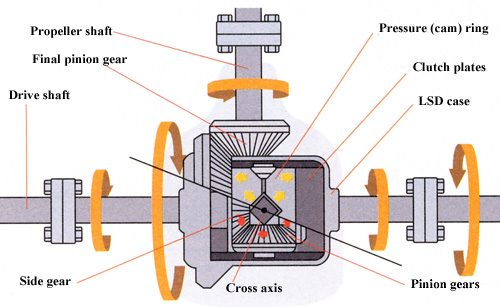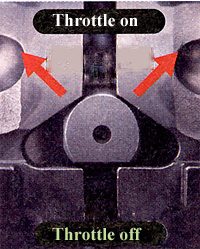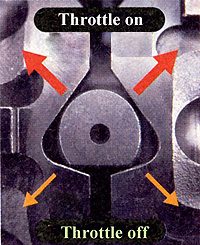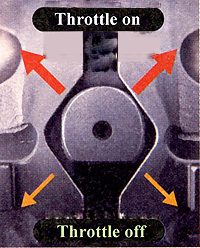- 1,460

- England
Evening all.
So, over the time I have spent here at GTPlanet, it has become apparent that many members here in the drifting community seem to think that the equivalent to a fully locked or 'welded' diff is 5/60/60 (inital/accell/braking).
I have always believed however, that 60/60/60 is fully locked.
I just took a Nismo 270R around Tsukuba. First with a 60/60/60 diff, then with a 5/60/60.
I then loaded these two replays into the data logger, and scrutinised the rear wheel speeds throughout the Lap.
At no point did the 60/60/60 show any difference in rear wheel speeds.
The 5/60/60 showed up to 2mph difference in speed, on numerous occasions exiting bends.
Blue =60/60/60
Pink =5/60/60

Try it yourself if you don't believe me.
If you want to run the equivalent of a locked 'welded' diff, run 60/60/60.
Have a good night

(love the data logger btw!)
Edit
This thread has some great info in it.
Here's a couple of bits from @Ridox2JZGTE and @ITSHAM. Thanks alot for the contributions guys.
So, over the time I have spent here at GTPlanet, it has become apparent that many members here in the drifting community seem to think that the equivalent to a fully locked or 'welded' diff is 5/60/60 (inital/accell/braking).
I have always believed however, that 60/60/60 is fully locked.
I just took a Nismo 270R around Tsukuba. First with a 60/60/60 diff, then with a 5/60/60.
I then loaded these two replays into the data logger, and scrutinised the rear wheel speeds throughout the Lap.
At no point did the 60/60/60 show any difference in rear wheel speeds.
The 5/60/60 showed up to 2mph difference in speed, on numerous occasions exiting bends.
Blue =60/60/60
Pink =5/60/60
Try it yourself if you don't believe me.
If you want to run the equivalent of a locked 'welded' diff, run 60/60/60.
Have a good night


(love the data logger btw!)
Edit
This thread has some great info in it.
Here's a couple of bits from @Ridox2JZGTE and @ITSHAM. Thanks alot for the contributions guys.
For LSD, the initial torque has nothing to do with differentiating 1 way, 1.5 way or 2 way.
1 way = LSD only work in acceleration, in GT6, braking can only go as low as 5, so a true 1 way is not possible. CUSCO 1 way 55/0
1.5 way = LSD works on both acceleration and braking, but the braking/coasting is less effective than acceleration, doesn't have to be half of it, NISMO GT LSD 1.5 way has 45/1 cam angle, while CUSCO on one of the model has 55/20 and Tomei LSD has 60/40 cam angle for 1.5 way.
2 way = LSD works on both acceleration and braking, usually both are the same in effectiveness, but there are LSD in 2 way with less braking. NISMO GT LSD and GT Pro 2 way has 55/45 cam angle, while NISMO GT TT has 45/45 cam angle.
The initial torque decides how early/late or when the LSD will activate ( the spring ), while accel and braking value adjust how much lock and how quick they will lock ( sort of a combination of cam / ramp angle - how quick/reaction time, number of plates + diameter - how much pressure/lock )
Initial torque or preload forces all driven wheels to rotate at the same speed even if there's no wheel spins or torque applied on the LSD. Initial torque decides how responsive is the LSD and how the car behaves in corners, most race cars or high powered cars uses high initial torque, but there' a limit where the preload will overcome the tires traction and do not allow them to rotate at differing speeds. So basically more/higher initial torque stabilize the car, reduces the chances of wheel spin under braking and acceleration, and gives more understeer. This is similar to GT6, where higher initial torque will give less drastic changes in car behavior, more stable/tigher and prone to understeer. Running car with low initial torque will make the car more loose, which is why most street car with LSD has low initial torque. The high value of initial on some stock LSD in GT6 is to simulate viscous LSD or torsen LSD in some cases ( those 50/80/0 - this seems to work differently to custom LSD )
When setting up initial torque, take consideration on locking rate of the acceleration and brake, I have been running medium to high initial torque/preload and quite high locking on accel and brake with great success - mostly on race cars and replicasHope this clear things up more @FussyFez
LSD - mechanism, function, & benefit
LSD and open differential LSD is an acronym for Limited Slip Differential. It is a gear mechanism which limits the rotational difference of the out-put shafts.
An “Open Differential” (as compared with LSD) allows the transfers of power to the wheel/s which are experiencing the least amount of resistance. This enables a car’s wheels with the least resistance to run at different speeds in a turn. As an example, when cornering, the inner wheel travels a shorter distance than the outer wheel. With an “Open Differential” you will experience easier handling during a turn. However, an “Open Differential” may not necessarily produce the best results for Racing, Drifting, and other Performance Driving. Why does LSD improve your driving performance? When cornering in competition or a racing situation, you will frequently experience body roll where one wheel of the car is lifted from the ground. This will cause the “Open Differential” to transfer all the torque to the wheel lifted rather than to the wheel that is on the ground. The results are a useless “wheel spin” where as the car loses its forward momentum. In order to eliminate the “spin”, your LSD will transfer the torque to both wheels which consequently improve your lapping time. The benefit of a performance LSD is quite obvious in the autocross or in a road race with many tight corners, but the benefit is not limited to those situations.
In Drifting, an “Open Differential” makes it very difficult to control vehicle’s slide with throttle actuation. LSD will allow the driver to steer the car with the throttle, allowing larger, more dramatic slide with plenty of forward movement.
In Drag Racing, the impact of an LSD is less dramatic. However, during sudden high-power starts and while up-shifting during acceleration, it is possible that either the left or the right tire can frequently slip. A performance LSD will quickly detect that condition and lock the differential so that you do not lose any time. Not even a few tenths of a second is wasted!
Types of LSD There are several types of LSDs.
Viscous type
By utilizing the torque generated from your oil viscosity, a “Viscous Type” LSD activates through viscous coupling that are sensitive to the rotational differences. Example – the Nissan 350Z is quipped with a Viscous Type LSD.
Helical type A Helical Type LSD has internal helical gears which produces friction resistance and activates itself depending on the input torque value. The maintenance is almost free for the life of the car. Example – stock LSD for Honda S2000.
Torque sensitive type Similar to a Helical Type LSD, a Torque Sensitive LSD uses friction resistance from the internal gears. The effectiveness varies depending on the torque input. Generally a Torque Sensitive LSD requires a large amount of torque input whereas a small value of torque does not have much impact on the LSD’s activation. Example – stock LSD for Mazda RX8.
Above mentioned LSDs are frequently chosen by many car manufacturers due to the advantage on easy maintenance and very little noise levels. However, when it comes down to the high-performance driving, professional drivers will always choose a Clutch Type (also called as a mechanical type).Clutch type (All ATS LSDs are clutch type)
A Clutch Type LSD has several (4 to 24) internal clutch plates. The LSD is activated by pressuring the clutch plates which will produce a very strong locking performance and superior response during performance driving.

In general, a Clutch Type LSD has pressure rings and friction plates inside the differential case. The LSD acts like as a standard differential when a car is moving straight or the rotational difference between left and right wheels are similar. Once there is a rotational difference among wheels, the cross axis which is set in the middle will press the pressure rings, then the pressure rings will transfer the movement to the clutch plates. When all the clutch plates are engaged, both wheels are locked and the torque is transferred equally to both wheels.
LSD activation mechanism - 1 way, 1.5 way, & 2 way



1 way
An LSD is activated only when the throttle is on and when the internal cam rings has an angle on only one side. 1.5 way
The angle of the cam rings for the off-side is very close to 5-20 degrees which will make the LSD ineffective when the throttle is off (during deceleration). The ATS 1.5-Way LSD will work similar to 1-Way LSD during deceleration2 way
The 2-Way cam rings angle are cut in the same degree on both sides (throttle on and throttle off sides). A 2-Way LSD will activate during both acceleration and deceleration. 2 way is a popular choice for drifting.
Initial torque & cam angle The initial torque (break away torque) is a pre-load torque on a LSD. Up to that torque load, the LSD locks the differential even without any rotational difference between the wheels. The initial torque and the cam angle on the cam rings determine the responsiveness of the LSD on the driver's steering and throttle inputs. The higher the initial torque and the higher the cam angle, the more responsive an LSD becomes. However, too much initial torque makes a vehicle extremely hard to turn and very high cam angle affect the vehicle's smoothness. A good performance LSD achieves an excellent balance of those two important factors.
Is a clutch type LSD noisy?? The concept that a clutch type LSD chatters and very noisy is out of date. ATS carbon LSD surprised many people with that quietness and effectiveness. This year (2009), ATS introduced super silent LSD which is a metal LSD but it does not chatter.
Diameter and the number of internal discs & lock ratio (added in Feb 2011) As in a performance clutch, the diameter of and the number of the disc inside the LSD case determine the absolute torque delivery capacity. The bigger the disc and the more discs are used internally, the larger the absolute locking power becomes.
By rearranging the internal discs, it is possible to reduce the maximum locking capacity of an LSD. For example, in the case of standard ATS metal LSD with 16 discs, the internal discs are arranged by A-B-A-B-A-B-A-B-Cam Ring-B-A-B-A-B-A-B-A. (where A is a disc with outside edge and B is a disc with inside edge). If you change the order to A-A-B-B-A-B-A-B-Cam Ring-B-A-B-A-B-B-A-A, the effective disc number have been changed from 16 to 12, which is a 25 % reduction. Consequently, the maximum locking capacity is reduced by 25 %.
Please note that reducing the maximum capacity by 25 % does not automatically mean the locking ratio is also reduced by 25 % . The locking ratio is determined by the engine output, the tire characteristics, the suspension set up, the radius of a corner, and the road surface condition. It is possible that even with the reduced maximum capacity, the LSD still locks 100 %. It is ATS's current position that it is difficult to set a specific locking ratio like 80 % lock or 50 % lock for an LSD since the locking ratio is dynamic not static determined by the factors mentioned here.
Hope this helps...
Last edited:

